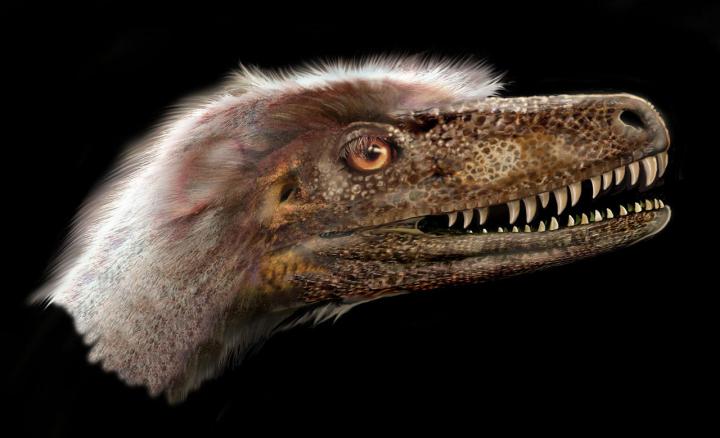Discovery provides valuable insight into evolution of theropod dinosaurs around the world

Credit: Jan Sovak
The discovery of a nearly complete dromaeosaurid Saurornitholestes langstoni specimen is providing critical information for the evolution of theropod dinosaurs, according to new research by a University of Alberta paleontologist.
The 76-million-year-old species was long thought to be so closely related to Velociraptor from Mongolia that some researchers even called it Velociraptor langstoni–until now.
The landmark discovery was made by world-renowned paleontologists Philip Currie and Clive Coy from the University of Alberta and David Evans, James and Louise Temerty Endowed Chair of Vertebrate Palaeontology at the Royal Ontario Museum. The research illustrates how Saurornitholestes differs from Velociraptor. Importantly, the research also identifies a unique tooth evolved for preening feathers and provides new evidence that the dromaeosaurid lineage from North America that includes Saurornitholestes is distinct from an Asian lineage that includes the famous Velociraptor.
“Palaeontology in general is a gigantic puzzle where most of the pieces are missing. The discovery and description of this specimen represents the recovery of many pieces of the puzzle,” said Currie, professor in the Department of Biological Sciences and Canada Research Chair in Dinosaur Paleobiology. “This ranks in the top discoveries of my career. It is pretty amazing.”
Another piece of the puzzle
Saurornitholestes is a small, feathered carnivorous dinosaur within the dromaeosaurid family (also known as “raptors”) that was previously known from fragmentary remains. Discovered by Coy in Dinosaur Provincial Park in 2014, the new skeleton is remarkably complete and exquisitely preserved, with all the bones (except for the tail) preserved in life position. The new research, which focuses on the skull, shows that the North American form has a shorter and deeper skull than the Velociraptor. At the front of the skull’s mouth, the researchers also discovered a flat tooth with long ridges, which was likely used for preening feathers. The same tooth has since been identified in Velociraptor and other dromaeosaurids.
“Because of their small size and delicate bones, small meat-eating dinosaur skeletons are exceptionally rare in the fossil record. The new skeleton is by far the most complete and best-preserved raptor skeleton ever found in North America. It’s a scientific goldmine,” said Evans.
The study also establishes a distinction between dromaeosaurids in North America and Asia. “The new anatomical information we have clearly shows that the North American dromaeosaurids are a separate lineage from the Asian dromaeosaurids, although they do have a common ancestor,” said Currie. “This changes our understanding of intercontinental movements of these animals and ultimately will help us understand their evolution.”
Future research will investigate the remainder of the skeleton as well as additional analyses on the relationships between dromaeosaurids.
###
The paper, “Cranial Anatomy of New Specimens of Saurornitholestes langstoni (Dinosauria, Theropoda, Dromaeosauridae) from the Dinosaur Park Formation (Campanian) of Alberta,” was published in The Anatomical Record (doi: 10.1002/ar.24241).
Media Contact
Katie Willis
[email protected]
780-267-0880
Original Source
https:/
Related Journal Article
http://dx.




